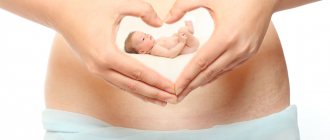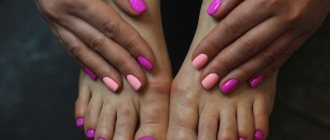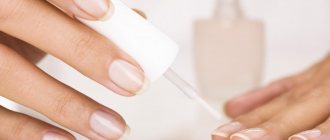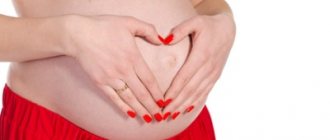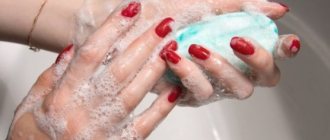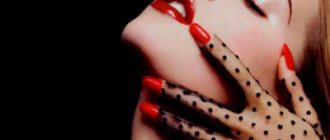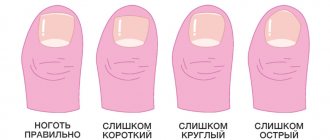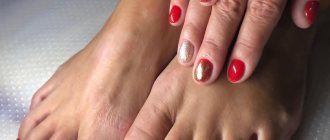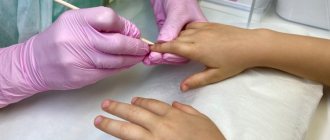In this article, we will look at whether it is possible for pregnant women to have manicures and pedicures and which type is better to choose, and we will also answer the question of whether it is safe to do nail extensions during pregnancy, whether it is harmful to use varnishes, and we will look step by step at the process of creating a stylish nail design for pregnant women.
Without exception, all women and girls strive to make their hands and feet well-groomed, and during pregnancy, when not only the physiological state changes, but also the psycho-emotional one, expectant mothers especially want to pamper themselves and be beautiful. But immediately doubts and questions arise about the safety and benefits of manicure procedures. Let's discuss all these doubts in detail.
Manicure
The procedure includes several stages: shaping the nails, removing cuticles and caring for the skin around the nails, covering with transparent or pigmented varnish.
There are several types of manicure:
- Edged or classic. The most common type of manicure, which is performed both in the salon and at home. The hands are lowered into a warm bath for a few minutes, and then cuticles, skin, and hangnails are removed with scissors or tweezers, and the free edges of the nails are shaped. The danger of this type of manicure lies in the possibility of infection when using untreated tools;
- Unedged or European. The cuticle is pre-treated with a special product that softens it. After this, it is moved back and removed with an orange stick;
- Hardware. It is performed using a sander, which removes cuticles and dead skin cells from the periungual ridges without trimming, damage or risk of infection.
- SPA manicure, during which natural remedies, massages, baths, and various pleasant procedures are used to improve the condition of the nails and skin.
Expectant mothers are not prohibited from getting a manicure, but it is recommended not to use the classic type of procedure in order to avoid infection, skin damage, and further inflammatory processes. All other types of manicure can be used not only to care for your hands, but also to lift your spirits.
Types of SPA manicure, how it is done and necessary cosmetics
Manicure and pedicure during pregnancy
Manicures and pedicures are absolutely not contraindicated for pregnant women. On the contrary, confidence in one’s impeccable appearance has a relaxing effect on any woman, softening mood swings that are caused by hormonal surges. But, like any procedure involving the use of cutting objects, as well as the use of chemicals, manicure and pedicure can sometimes be unsafe.
Manicure (Latin manus - brush, cura - care) is a set of cosmetic procedures for hand care.
Pedicure (lat. pedis - foot, cure - care) is a set of cosmetic procedures for foot care.
Why you should pay special attention to nail care during pregnancy
During pregnancy, nails can undergo dramatic changes. Hormonal changes in the body and a lack of calcium can lead to thinning of the nail plate. The skin on your hands and feet may become dry and begin to peel. All this gives a sloppy look to the hands and feet. Moreover, the formation of hangnails and microcracks on the heels can lead to skin infection. Therefore, a pregnant woman should increase her care for her fingernails and toenails.
During pregnancy, the nail plate may become thinner and nails may begin to peel.
An expectant mother can afford both a manicure and a pedicure with a light heart. It is only important to use harmless substances and sterile instruments.
Chemical composition of varnish
The basic components of varnishes from different manufacturers are generally the same. The difference may be in some additional substances. Information about the composition can be found on the packaging.
Particular attention should be paid to the presence of 5 components. They are prohibited in the EU, USA, Japan and some other countries. Hazardous substances include:
- Formaldehyde is a colorless gas. It acts as a preservative, ensuring long-term storage of varnish. Formaldehyde is very allergenic. An allergic reaction may be accompanied by chemical burns and dermatitis. Women with hypersensitivity should be extremely careful when using varnishes containing this component.
- Toluene is a solvent. It creates a smoother finish and prevents color fading. This substance may affect the central nervous system and reproductive function. Nausea, dizziness, fainting are all surprises you can expect from toluene.
- Camphor (camphor) – intended for gloss. Camphor is not as harmful as it might seem. For example, it is used in the manufacture of nasal sprays to treat runny nose. But it can also cause allergic reactions. Inhaling camphor vapors causes headaches and nausea.
- Dibutyl Phthalate – flavoring. Causes endocrine disruption, affects the reproductive organs and respiratory organs.
- Formaldehyde resins are a derivative complex of substances based on formaldehyde. The body's reaction is identical to the reaction to formaldehyde.
When purchasing this or that varnish or choosing it at an appointment with a specialist in the salon, you should definitely look at the composition. If it contains at least three of the above components, then it is better not to use it. If you see the designation “5-Free” or “3-Free” on the packaging, you can count on the fact that this varnish does not contain 5 or 3 components, respectively:
- “5-Free” – all 5 components listed above are not available;
- “3-Free” - only formaldehyde, toluene and dibutyl phthalate are free.
The manufacturer must place the “5-Free” or “3-Free” mark on the front side of the product
Safety of the procedure
Manicure is a procedure that involves the use of piercing and cutting instruments. Therefore, strict adherence to sterilization rules is the key to safety. If the instrument is individual, then there is nothing much to worry about. It is enough to wash the instrument well with soap, immerse it in a disinfectant solution, for example, Alaminol, leave for a certain time and dry.
But when visiting the salon, don’t be shy. Asking for a health certificate, looking at the certificate of the master and cosmetics, asking to open a disinfectant package with tools in personal presence - there is nothing wrong with that. It is important to remember that during pregnancy, responsibility for the health of the baby lies entirely with the expectant mother.
Sterilization of manicure instruments that come into contact with human skin is a prerequisite for maintaining hygiene and safety.
What types of manicure and pedicure are best?
In order to choose a procedure that is suitable for yourself, you need to know the main types of manicure and pedicure (they are absolutely identical):
- Edged is a classic option. After shaping the nails, the hands are immersed in a bath of warm water to soften the skin. Then the cuticle is trimmed. If desired, the nails are either polished or varnished. This is one of the most dangerous types of manicure and pedicure, as the master can cause injury by cutting the cuticle and cause infection. Panaritium (purulent inflammation) - a frequent companion to this procedure - is treated with antibiotics and sometimes with surgery. Not the best bonus to the procedure, especially during pregnancy.
- European (unedged) - in European countries this is what they prefer. Its peculiarity lies in treating the cuticle with emollients and pushing it back with an orange stick. This type of procedure is the safest.
- Hardware - when carrying out this type of procedure, a special device is used. The softened cuticle is removed by grinding, which eliminates the possibility of cutting. But the risk of microtrauma is still present.
Nail coating
Now let's talk about coating the nails with gel polish, when used, vapors of the chemical compounds included in the composition appear.
The health of the pregnant woman and the developing fetus can be negatively affected by the following components:
- Formaldehyde, which has an unpleasant odor. Helps to better adhere the natural plate to the varnish, can cause allergies, headaches, tachycardia, affect the central nervous system and cause developmental defects;
- Toluene, which helps accelerate the drying of the varnish and its long service life. Is a strong solvent. Entering the body through the respiratory tract, it can negatively affect the development of the fetus;
- Butylated hydroxyanisole, which can cause cancer;
- Camphor can increase uterine tone and affect the cardiovascular system of a pregnant woman.
Before applying the varnish, make sure that it does not contain the components listed above.
Health hazards of gel polish and its components
Recommendations and tips
To ensure that a trip to a manicurist does not end in disappointment and unpleasant consequences, you must follow a number of recommendations. Including:
- do not contact professionals who work at home;
- before putting your hands into the UV lamp, you must use cream;
- It is advisable to perform manicure in a well-ventilated area;
- It is important that the chair is comfortable;
- use only quality products.
Shellac from a good company has an identification mark. Typically this is the lot's license plate number. If it is not on the box, there is a high probability that the material is of poor quality.
There is no need to refuse manicures and pedicures if there are no concerns or doctor’s orders. When choosing between regular varnish and shellac, it is better to choose the latter option.
The fact is that the varnish requires replacement every three to five days, and it must be removed with acetone, the use of which is contraindicated during pregnancy. Real shellac does not have a strong odor. It is important to have a manicure performed by a trusted specialist who uses only high-quality and safe materials.
Pros and cons of gel polish coating
Let's look at the advantages and disadvantages of the procedure to figure out whether it is advisable to cover your nails during pregnancy. It’s worth saying right away that the safest coating that exists in the nail industry today is shellac. This is due to the following factors:
- A manicure using shellac is done faster than with gel polish, literally within half an hour;
- The execution technique does not require the application of a primer, which already reduces the amount of hazardous materials. It is enough to use only a degreaser;
- There is no need to sand or file the nail plate, so shellac is ideal for thin nails;
- The nail is not injured during the process of removing shellac, because this is done with a regular acetone-free product, which also reduces the amount of harmful substances.
Among the highest quality shellacs, we can recommend the CND and Axxium brand products from OPI. Shellacs stay on nails for a long time without chipping, have bright, rich shades, self-level and dry quickly.
Color Club - good gel polishes of the 10-Free category:
So, the advantages of the procedure for applying a pigmented gel product include the following:
- Durability. The procedure can be carried out much less frequently than when using conventional varnish;
- The nutritional components used in the manicure process strengthen the nails and prevent the plate from delaminating;
- The nail plates are not clogged and can breathe;
- When applying shellac, there is no need to remove the top layer of the nail, so the plate will not become thinner or be injured;
- You can cover your nails with safe varnish after the first 12 weeks of pregnancy.
The disadvantages include the following:
- During the manicure process, solvents are used, the fumes of which can cause allergies, dizziness and nausea in the pregnant woman;
- Due to hormonal fluctuations, the coating may last significantly less than the specified period, peel off, crack, or even move away from the nail plate almost immediately;
- The procedure is performed over a long period of time, which can negatively affect the condition of the expectant mother who is in the last weeks of pregnancy;
- Coating with any type of varnish is not recommended during the first 12 weeks of pregnancy, when the fetus is actively developing and the female body is adapting to new conditions.
Gel polish during pregnancy: reviews from women
Toxic materials can have a much more serious effect than many medications. At the same time, many pregnant women do not think about the danger that low-quality varnish containing harmful components can bring. According to reviews, pregnant women often apply gel polish throughout pregnancy and do not notice any abnormalities. At the same time, there are those who try to play it safe and not get carried away with cosmetic procedures while expecting a baby. Fortunately, there are no reliable results on the negative impact of manicure with gel polish on the course of pregnancy or the formation of fetal pathologies.
Even if the pregnancy is progressing well and the woman has no health problems, before the gel polish procedure it is strongly recommended to consult a gynecologist who is observing the pregnant woman. In addition, take the time to find out the name and composition of the products that will be used during the manicure and/or pedicure. In the first trimester of pregnancy, it is recommended to avoid using gel polish.
Useful tips
If the expectant mother nevertheless decides to paint her nails, then it is recommended to adhere to some simple rules in order to minimize the risk of harming the fetus and the health of the mother herself:
- Carry out the procedure for covering your nails only in a trusted salon. You must be confident in the manicurist, in the sterility of the instruments, as well as in the quality and safety of the materials;
- The room should be ventilated and should not be stuffy. There should also be no sharp, irritating, caustic odors;
- If you are allergic to the sun's rays, then to protect your skin from ultraviolet radiation from a UV lamp, apply sunscreen with a high SPF value to your skin before a manicure. LED lamps can be used without any worries;
- It is recommended to take breaks between procedures for painting nails with gel polishes so that the nails can rest and it is possible to monitor the health of the pregnant woman based on their condition;
- If you have the opportunity and materials to apply shellac, rather than gel polish, to your nails, then it’s better to do so. Shellac is the safest product for decorative manicure;
- To remove nail polish, use liquids that do not contain acetone;
- Before each scheduled visit to the doctor, as well as a couple of weeks before the expected date of birth, the color coating must be removed, because nails are one of the important indicators of the health of a pregnant woman. This is done so that doctors can read the information and react in time in case of any problems.
Shellac during pregnancy: 5 tips
- The main disadvantage of using gel polish is the high cost of the procedure. However, the expectant mother should choose nail service professionals and not skimp on her and her child’s health. It is not recommended to visit a specialist at home, where it is difficult to ensure and check the sterility of the instruments.
- It is impossible to make shellac yourself without skills and equipment, just as it is impossible to remove shellac without damaging your nails without a special remover. To minimize the risk of inhaling harmful fumes, after the third trimester you should paint your nails and remove the old coating monthly - no more often.
- The multi-stage procedure for decorating nails can be tedious for the expectant mother, who finds it difficult to remain in the same position for 1.5-2 hours. Foreign odors provoke dizziness and nausea. Agree to the procedure only if comfort is provided in the room: an ergonomic chair, a flow of fresh air.
- The expectant mother’s body behaves unexpectedly: it rejects previously normally tolerated cosmetics. Apply shellac to one nail and check if there are any allergic reactions to it, and then decide to do shellac during pregnancy.
- Before setting the shellac under a UV lamp, be sure to treat the skin with sunscreen.
There is no clear answer to the question of whether to do shellac for pregnant women. It all depends on the individual characteristics of the body, the trimester of pregnancy, the quality of the shellac, the skill and experience of the nail specialist. If you follow the doctor’s recommendations and turn to professionals, the procedure will not harm the child and will please the mother.
Doctors' opinion
All doctors are unanimous in their opinion that it is better to refrain from applying any type of varnish to the nail plates during the first 12 weeks of pregnancy.
In the following weeks, it is not prohibited to apply nail polish, but it is important to use high-quality and as safe materials as possible. The normal course of pregnancy also plays an important role.
Contraindications for applying gel polish, which you should pay attention to first of all, are the following factors:
- Diseases and fungal infections on the nails or skin;
- Toxicosis;
- Allergic reactions;
- Peeling nails;
- Respiratory problems.
Nail health during pregnancy - prevention and treatment
Coating durability
Some ladies are afraid to do shellac during pregnancy, because during this period the decorative coating may fall off the nails within a day or two. According to manicurists, for a lasting decorative effect, it is often enough to choose the “right” shellac and a nail service specialist with an impeccable reputation.
The reasons for shellac deterioration are:
- regular pressure on the coating or damage from a sharp object;
- fungal disease and other nail diseases;
- taking certain medications;
- period;
- cheap base gel;
- insufficient degreasing of nail plates;
- the edge of the nail is not sealed;
- other wizard errors.
With vitamin deficiency that accompanies pregnancy and hormonal changes in the body, increased sensitivity of the nails and fragility of the plates cannot be ruled out. As a result, the life of an attractive manicure is shortened. Unfortunately, no expectant mother is immune from shellac rejection - it is difficult to predict what whim the rebuilding body will throw out.
Nail design ideas for the expectant mother
Of course, pregnant women are recommended to have either short nails or moderately long ones. Taking into account the woman’s position and the length of the nail plates, you can choose the following options for manicure, which are guaranteed to lift your spirits, make your nails well-groomed and look harmonious:
- Minimalistic. The marigolds are painted with one pigment, the shade of which depends on the preferences of the pregnant woman.
- French. Classic never goes out of fashion, always pleases with its perfection and, moreover, looks chic on short nails. If desired, the jacket can be colored, add small accents in the form of small patterns, sparkles, lace.
Design options for a French jacket - a selection of ideas - Lunar. You can also diversify with color options, negative space, and ornaments.
Exquisite moon manicure: instructions, ideas, spring trends and tips - Feng Shui. Each nail is painted a different color. The main thing is that all colors are harmoniously combined with each other.
- With an image. It can be any pattern or ornament. It all depends on the preferences of the pregnant woman and the professionalism of the specialist. Often expectant mothers choose an image on their nails in the form of a stroller, small arms, legs, a pacifier, or a stork.
- Gradient, also known as ombre, which can visually make nails longer. A smooth flow of a dark shade from the cuticle area to a lighter one towards the end of the free edge will make short nails visually longer and narrower.
What is manicure, its types and popular nail design options
Let's take a step-by-step look at the process of creating a bright rainbow design that looks very stylish on short nails and lifts your spirits:
- Apply a leveling layer of base and dry it in a lamp.
- Apply the base color in two layers to all nails except the middle and index fingers. Apply the second layer after drying the first and also dry it in a lamp.
- Cover the painted nails with a top coat and dry in a lamp.
- We place on a palette, foil or silicone mat a certain amount of colored varnishes that will be used to create a rainbow. You can choose all seven rainbow shades, or limit yourself to a few that will be clearly visible.
- Using a thin brush, apply the color of the rainbow to two free nails in an arbitrary place so that the rainbow on the ring finger is a continuation of the bend of the rainbow on the nail of the middle finger.
- Using a flat brush, blend the colors, slightly mixing adjacent shades with each other, creating a gradient. Dry it in a lamp.
- We duplicate the color on the nails for brightness, repeat the process of mixing shades and dry it in a lamp.
- Cover with topcoat and keep in the lamp until completely dry. As a result, we get a very bright, cheerful and fashionable nail art.
Contraindications
In certain situations, the use of decorative coating should be abandoned. Painting nails is prohibited in the following cases :
- the presence of fungal infections;
- toxicosis;
- risk of miscarriage;
- allergic reaction to varnish components.
Carrying out a manicure with painting the nail plate in the presence of contraindications is fraught with the appearance of unwanted reactions. When inhaling dangerous substances, a woman develops a headache and a jump in blood pressure. If there is a lack of oxygen, fainting may occur.
Advice . To keep your nails in good condition, it is advisable to use rubber gloves when cleaning at home.
Nail extensions
Now let's talk about whether it is dangerous to grow nails during pregnancy. The situation with artificial nails looks approximately the same as with coating nails with gel polish. There is no clear opinion on this issue. A pregnant woman herself decides whether to have artificial plates. Naturally, the first trimester, that is, the first 12 weeks of pregnancy, should pass without any manipulation of the nails. For the further period of gestation, there are some recommendations for nail extensions:
- Use of quality materials by a qualified and responsible craftsman;
- It’s definitely better to avoid acrylic. It is preferable to choose a gel, or even better to choose a biogel, which is considered safe and does not require cutting off the upper natural layers, but is no less effective;
- During the entire procedure, it is recommended to wear a protective medical mask and gloves with cut off fingertips to minimize the influence of lamp radiation and inhalation of material fumes and dust from sanding layers;
- If after the extension procedure the condition of natural nails has become worse than before the procedure, then it is better to avoid artificial nails for the entire period of pregnancy.
Is it possible to continue working during pregnancy if the woman is a nail technician?
While it is easier for clients of nail salons to completely refuse services during pregnancy, nail salons find it difficult for nail salons. Few people can afford a long vacation to bear and raise a child, so you need to adapt to the situation.
If it is not possible to leave work, refuse procedures using aggressive chemicals, for example, only give clients manicures and cover your nails with harmless varnish
The following recommendations help pregnant manicurists maintain themselves in good condition:
- ventilate the office as often as possible;
- Make sure the ventilation is working properly - work at a table that has a built-in ventilation system. Or at least try to keep your work area closer to the ventilation openings;
- Try to empty trash containers as often as possible and close them tightly;
- Buy disposable respirator masks at the pharmacy and wear them to protect against inhalation of small particles and dust. Don’t forget to change them often - preferably after each client, but at least once every 2-3 hours;
- Wash your hands before each client and after serving them;
- use gloves to protect your skin from harmful substances;
- Make sure that while working you are wearing clothing that completely covers your entire body below the neck;
- Complete each stage of the procedure by changing cotton towels and napkins;
- minimize the number of services that require the use of toxic substances and preparations containing methyl methacrylate, acetone, formaldehyde, toluene and phthalates;
- Wash your hands and take off your work clothes before eating;
- Store food brought from home in a closed container at low temperature;
- eat and drink in designated areas and not at your desk;
- Allow time to warm up between client visits;
- meticulously select furniture for your workplace so that your posture while working is as comfortable as possible.
All these rules for masters and their clients apply equally to salon procedures and those performed at home.
Pedicure
A set of procedures for nails and skin on the feet is not contraindicated for pregnant women, but must be selected and carried out with caution. Considering the fact that pedicure is aimed not only at working with nails, but also at softening the skin of the feet, removing calluses and corns, it is worth choosing a hardware type of pedicure or an unedged one. Intensive massage should be avoided due to the presence of many active points on the feet. It is recommended to limit yourself to light stroking.
SPA Pedicure - description of all types and technologies
If a woman usually does a pedicure on her own, then in the second half of pregnancy it will be problematic to carry out such a procedure. At this time, it is better to use the services of a trusted salon or ask your husband for help.
You should not take steam baths or generally use water with a temperature of more than 45 degrees, so as not to cause blood flow to the legs, which can cause varicose veins.
General recommendations for a safe pedicure are identical to those for hand care.
The only thing you need to pay attention to is that it is better to perform a pedicure for a pregnant woman reclining on her side to avoid excessive tension in the lower back.
What is a hardware pedicure and its quality criteria
Body care
First of all, pregnancy and cosmetics are not mutually exclusive concepts; it’s just that while you’re expecting a baby, it’s better to give preference to natural and hypoallergenic products. Now there are quite a few brands to suit a variety of budgets with lines of care products for pregnant women.
If you don't trust them, you can try using homemade recipes based on natural ingredients. Olive oil, coconut oil, wheat germ oil and almond oil perfectly moisturize the body and help fight against stretch marks. To improve the condition of your body skin, you can use a sugar or salt scrub once or twice a week: simply apply fine salt in a circular motion to damp skin, and then rinse with water.
Useful procedures for pregnant women
During pregnancy, all types of SPA manicure aimed at moisturizing, nourishing and softening will have a beneficial effect on the condition of the nails and skin of the hands. You can use cosmetic products for massage containing vitamins, minerals, glycerin and other beneficial substances, or you can use folk remedies and pamper your hands with various warm baths at home, and then apply olive oil with light massage movements.
Pregnant women who experience discomfort from swelling and tired legs will especially enjoy a gently cooling mud wrap that will relieve fatigue, reduce swelling and restore joint function.
To do this, you can use a ready-made mask that already contains cooling ingredients such as menthol and mint, or dilute the powder mixture with water at a temperature of about twenty degrees. The composition is applied to the legs and left for 10-20 minutes. It is not recommended to keep it longer.
During pregnancy, you should not refuse caring procedures for your hands and feet, but you should choose them carefully and responsibly, so as not to harm yourself and the baby.
It is best to consult with your supervising physician before deciding to undergo any procedure. Comment
Rules for the procedure
To avoid negative consequences, it is necessary to extend nails in conditions that are safe for the health of a pregnant woman.
These include:
- Ventilation of the room in which the procedure takes place. To avoid intoxication of the body, it is necessary to periodically open the windows. The main condition is positive temperature outside the window, absence of drafts .
- Using a protective mask. If it is not possible to ventilate the room, it is necessary to use special masks that protect against the evaporation of toxic components.
- Notification about the manufacturer and properties of the product that will be used by the master to create a manicure.
- Using a vacuum cleaner. In order not to breathe dust from microparticles of the gel that enter the air when cutting it down, you need to use a desktop vacuum cleaner to eliminate harmful elements.
If a woman’s condition worsens sharply during the procedure, it is necessary to stop the process and go out into fresh air.
Removing shellac
Removing gel polish during pregnancy requires caution, using auxiliary components. The procedure uses medications that contain calcium, minerals and vitamins.
To avoid harm to the nail plate, it is recommended to have the coating removed by an experienced specialist.
Advice for pregnant women
The final decision remains only with the woman, but it is still important to listen to the recommendations:
- Get your manicure done only in trusted salons. All instruments must be sterilized.
- The air in the office should be fresh and clean, and most importantly, free of pungent odors.
- Protect your hands from ultraviolet radiation. Use sunscreen before going to the salon.
- Cover your nails only with high-quality shellac.
- If you feel unwell, have a headache, or your general condition worsens, then the procedure must be completed.
Basic safety rules
The negative impact of varnish can be reduced if you follow safety rules . These include the following:
- The room in which manicure is done should be well ventilated.
- You should not skimp on materials and tools for manicure.
- Dust generated as a result of filing nails can get on the nasal mucosa. It is recommended to rinse it after the procedure.
- The coating remover should not contain acetone.
- Tools are treated with an antiseptic not only in the salon, but also when performing a manicure at home.
Practice shows that painting nails during pregnancy does not cause significant harm if you follow the main principles of the procedure. If your general condition worsens or an allergic reaction occurs, you should avoid applying varnish to the nail plate.

